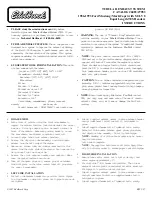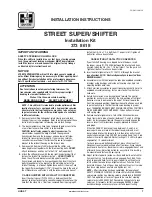
08 Starting and driving
08
}}
*
Option/accessory, for more information, see Introduction.
261
ECO*
Eco is a function
10
developed by Volvo to give
the driver the opportunity to actively drive
more economically and to help reduce fuel
consumption.
Introduction
When Eco is activated, the
following functions are modi-
fied:
•
The automatic transmission's shifting
points
•
The engine management system and
accelerator pedal response
•
Stop/stop function (Start/Stop – introduc-
tion (p. 256)): the engine can auto-stop
before the vehicle has come to a full stop
•
Eco Coast functionality is activated:
engine braking is disabled
•
Climate system settings: certain functions
(e.g., air conditioning) will be temporarily
reduced or deactivated
NOTE
When Eco is activated, several climate
system parameters are changed and the
function of certain current-consuming sys-
tems will be reduced.
Some of these functions can be restarted
manually but full functionality will not be
restored until Eco is deactivated.
Function
ECO On/Off button in the center console
ECO symbol in the instrument panel
When the engine is switched off, ECO is
deactivated and must be reactivated each
time the engine is started (with the exception
of certain engines).
The
ECO
symbol will be displayed in the
instrument panel and the indicator light in the
ECO
button will be
on
when Eco is activated.
Eco on or off
When ECO is deactivated,
the
ECO
symbol will
not
be
displayed in the instrument
panel and the indicator light
in the
ECO
button will be
off
.
The function will remain
deactivated until the button
is pressed again.
Eco Coast
Eco Coast is an integral part of the Eco func-
tion and essentially deactivates engine brak-
ing, allowing the vehicle to roll freely.
NOTE
To function optimally, Eco Coast should
primarily be used when the vehicle can
coast as far as possible.
When the driver releases the accelerator
pedal, the transmission is automatically dis-
engaged from the engine and engine rpm will
be reduced to the idle level
(approx. 700-800 rpm), which helps reduce
fuel consumption.
10
Option on models equipped with certain 4-cylinder engines
Summary of Contents for XC 70
Page 1: ...WEB EDITION OWNER S MANUAL I n f o r ma t i o nP r o v i d e db y...
Page 2: ...I n f o r ma t i o nP r o v i d e db y...
Page 12: ...INTRODUCTION I n f o r ma t i o nP r o v i d e db y...
Page 27: ...SAFETY I n f o r ma t i o nP r o v i d e db y...
Page 65: ...INSTRUMENTS AND CONTROLS I n f o r ma t i o nP r o v i d e db y...
Page 67: ...03 Instruments and controls 03 65 I n f o r ma t i o nP r o v i d e db y...
Page 68: ...03 Instruments and controls 03 66 I n f o r ma t i o nP r o v i d e db y...
Page 125: ...CLIMATE I n f o r ma t i o nP r o v i d e db y...
Page 139: ...LOADING AND STORAGE I n f o r ma t i o nP r o v i d e db y...
Page 153: ...LOCKS AND ALARM I n f o r ma t i o nP r o v i d e db y...
Page 176: ...DRIVER SUPPORT I n f o r ma t i o nP r o v i d e db y...
Page 247: ...STARTING AND DRIVING I n f o r ma t i o nP r o v i d e db y...
Page 289: ...WHEELS AND TIRES I n f o r ma t i o nP r o v i d e db y...
Page 323: ...MAINTENANCE AND SERVICING I n f o r ma t i o nP r o v i d e db y...
Page 368: ...SPECIFICATIONS I n f o r ma t i o nP r o v i d e db y...
Page 370: ...11 Specifications 11 368 Location of labels I n f o r ma t i o nP r o v i d e db y...
Page 385: ...11 Specifications 11 383 I n f o r ma t i o nP r o v i d e db y...
Page 394: ...12 Index 12 392 I n f o r ma t i o nP r o v i d e db y...
















































